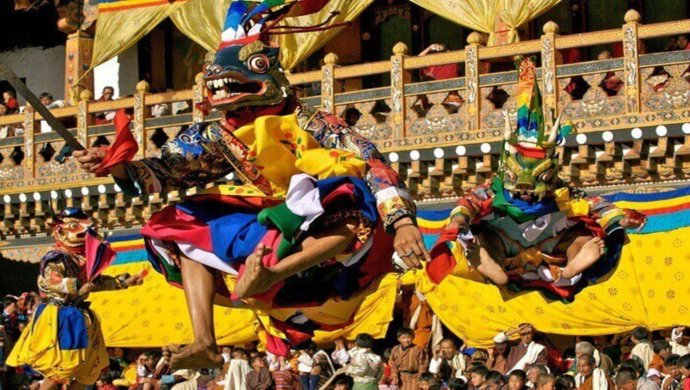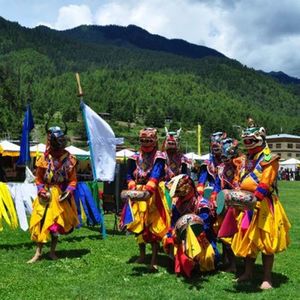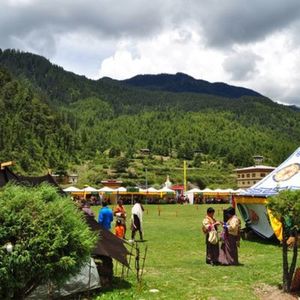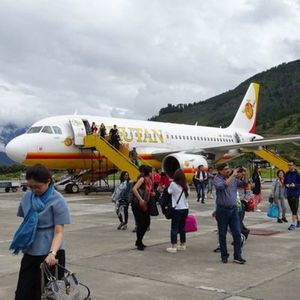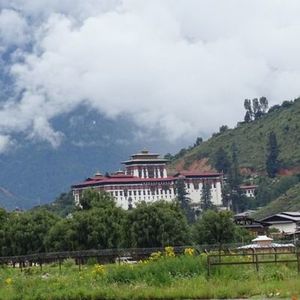Day 1. Arrive Paro:
Altitude of Paro: 2,280 m
Your flight to Paro on a clear day, is marked with the panoramic views of the Himalayas including the Everest and other famous Peaks. The approach through the foothills and the landing (including few steep turns) at the tiny airstrip of Paro has been termed as adventurous by many travelers. After the completion of immigration formalities at the Paro Airport exit door, you will be received by your Bhutanese guide with traditional “Tashi Khadar”. Thereafter you are driven to your hotel and do your check in. You can relax for the rest of the day. Lunch would be served at the hotel. In the evening, explore the Paro Town and valley.
Meals – Lunch and Dinner; Overnight at the Hotel in Paro.
Day 2. Paro Sightseeing:
After breakfast, start your day with a hike to
- Taktsang Monastery (Tiger's nest), the abode of gods and monks situated at an altitude of 3100m on the Upper Paro Valley, Bhutan. As per the legend, Guru Padmasambhana (Guru Rinpoche), the tantrum mystic who brought Buddhism to Bhutan, came in the form of Dorje Droloe riding a flying tigress to subdue the demon that was obstructing the spread of Buddhism in the Himalayas.
After the completion of the hike, you would be served picnic Lunch among the woods. After lunch, visit
- Kyichu Lhakhang, one of the oldest monasteries in Bhutan built in the 7th century by the Tibetan Emperor Songtsen Gampo
In the evening take a walk around Paro Town and valley. A short distance further is one of the innumerable archery grounds. Archery is the national sport of Bhutan). If we are lucky, we may catch a match in action. The evening ends with a walk through Paro's main shopping district.
Meals – Breakfast, Lunch and Dinner; Overnight at the Hotel in Paro.
Day 3. Paro - Haa:
Driving Distance: 65 kms, Driving Time: 2 hrs – 3 hrs, Altitude of Haa Valley: 2700 m
After breakfast, drive to Haa via Chele la Pass. Stop at Chele la pass and enjoy the view of High Mountains and the prayer flags. You can put up your own prayer flags here.
- Chele la (pass) is considered to be one of the highest motorable passes in Bhutan. The ride passes through lush valleys, pine and rhododendron forest. The pass provides stunning views of the sacred mountain Jomolhari and Jichu Drake.
Drive further to Haa Valley. Enroute stop for lunch. The valley was opened to foreign tourist only in the year 2002. The valley is also unparalleled in Bhutan in terms of the diversity of the folk culture, legends and shamanistic rituals. The shamanistic traditions are vividly practiced in almost all the communities, most notable of which is the annual ceremony to honor Ap Chundu, the Guardian Deity of the valley. The valley is also a paradise for nature lovers and travelling there is a very rewarding experience. In Haa, you can visit,
- 7th century Lhakhang Karpo (White temple) and Lhakhang Nagpo (Black temple) at the foothills of a venerated three brotherly mountains known as Meri Puensum. The grand annual Haa Tshechu is also performed here at Lhakhang Karpo on the 8th-10th day of the 8th Bhutanese month.
- Haa Wangchuk Lo Dzong built in 1915 after the Dumchog Dzong was razed to the ground by fire.
Meals – Breakfast, Lunch and Dinner; Overnight at the Hotel in Haa.
Day 4. Haa Sightseeing:
After breakfast, you would be driven to Haa Summer Festival Ground. You guide will let you know about the exact timing.
- Day 1 – Today during the festival, you would observe,
- The Annual Alpine Festival: You will see skilled local craftsmen weaving yak hair into traditional tents and also practicing traditional arts of yak shearing and wool making. You will also be able to see how delicious traditional meals are made using yak dairy products as main ingredients.
- Food, A Taste of Tradition: You will get to taste delicious Haapi Hoentoe, hearty dumplings made from buckwheat and stuffed with fragrant grated turnip, dried turnip greens, mushrooms, garlic, onions and chopped cabbage seasoned with ginger, ground walnut, chili-powder, salt, butter, sesame and poppy seeds. This is the special dish of Haa valley and made only by people of Haa Valley. You would also be able to sample traditional Bhutanese dishes.
- Song and Dance: You will get to watch and enjoy the folk songs and mask dances performed at this festival and also experience Haapi Ausa, traditional songs extolling the virtue of their yaks that are typically sung while tending their yaks.
Lunch would be served at a local restaurant. After the end of the day, you are driven back to the hotel.
Meals – Breakfast, Lunch and Dinner; Overnight at the Hotel in Haa.
Day 5. Haa - Thimphu:
Driving Distance 115 Kms; Driving time: 3 hrs - 4 hrs, Altitude of Thimphu: 2320 m.
After breakfast, drive to Thimphu. Lunch at a local restaurant in Thimphu. Later complete check in formalities. After lunch is a time to refresh in the cool breeze of the Himalayas with the perfect views of the Thimphu valley. Visit the following:
- Kuensel Phodrang, the gigantic Buddha Dordenma Statue located atop a hill in Kuensel Phodrang Nature Park.
- National Memorial Chhorten, a Stupa built in 1974 to honor the third Druk Gyalpo, Jigme Dorji Wangchuck. Every morning till night old people and young people circumambulate the Chhorten.
- Sangaygang View Point, also known as BBS Tower offering panoramic view of Thimphu Town situated at an elevation of 2,685 m.
- Takin Preserve Centre, see Takin (National animal of Bhutan) It is a unique combination of Goat and an Antelope
Evening free for leisure.
Meals – Breakfast, Lunch and Dinner. Overnight at the Hotel in Thimphu.
Day 6. Thimphu Sightseeing:
After breakfast, complete the balance sightseeing of the city. You would visit:
- Zorig Chusom, Premier institute of traditional arts and crafts in Thimphu established with an objective of preserving “thirteen arts and crafts of Bhutan”.
- Folk Heritage, traditional house giving an insight to the Bhutanese lifestyle, and artifacts from the rural households
- Changangkha Monastery, popular fortress like temple perched on a ridge above Central Thimphu built in 15th Century by Lama Phajo Drugom Zhipo.
- Textile Museum: This Textile Museum is operated by the National Commission for Cultural Affairs of Bhutan. The Museum was established in the year 2001 and has a good collection of exclusive and antique Bhutanese textile artifacts.
- Tashichhodzong, or ‘the fortress of the glorious religion’. Initially erected in 1641 by Shabdrung Ngawang Namgyal, it was rebuilt in the 1960s during the reign of Bhutan’s third king in the traditional style, without plans or nails. It houses some ministries, His Majesty’s secretariat, and the central monk body and opens after 5 PM.
Lunch would be served at a local restaurant. After the completion of sightseeing, you are driven back to your hotel. After relaxing for some time you are served with dinner.
Meals – Breakfast, Lunch and Dinner; Overnight at the Hotel in Thimphu.
Day 7. Thimphu - Paro:
Driving Distance: 65 Kms, Driving Hrs. 1.50 hrs – 2 hrs, Altitude of Paro: 2250 m.
After breakfast, drive to Paro. On the way, visit
- Visit Tamchog Lhakhang, located along Paro-Thimphu highway on the base of a mountain across the Pa Chhu River built in the early 15th century by the great iron bridge builder Thangtong Gyalpo.
After arrival in Paro, check in to the Hotel. In the Afternoon, post lunch visit
- Paro Rimpung Dzong, also known as Fortress of the heap of jewels, built during the time of Shabdrung Ngawang Namgyal in 1646.
- Ta Dzong, an ancient watch tower overlooking Rimpung Dzong built in 1951 now converted into national museum.
In the evening, explore the Paro Valley and town.
Meals – Breakfast, Lunch and Dinner; Overnight at the Hotel in Paro.
Day 8. Departure:
Today we will bid farewell to this beautiful country and take an early flight back. We hope by now you must have made some good friends and also have taken photographs and beautiful memories of Bhutan. We certainly hope of serving you again on your next visit to this great country or the Last Shangri-La. Tashi Delek.
